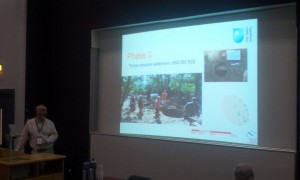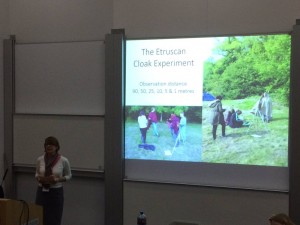Phil Perkins and Eleanor Betts represented the OU Classical Studies department at the Seventh Conference of Italian Archaeology, which was held at the National University of Ireland, Galway on 16th-19th April 2016. Scholars from 15 countries presented papers and posters on the archaeology and cultural history of Italy from prehistory to the modern period. Whilst the primary theme of the Conference was the archaeology of death, our papers considered some recent developments in Italian archaeology.
Phil spoke about the final excavation seasons at Poggio Colla and their context in Northern Etruria, focusing in particular on the remarkable stele which was discovered in Summer 2015. The stele was built into the wall of the earliest temple and bears one of the longest inscriptions known in Etruria. Phil will be presenting on this, and more, in the Accordia Lecture Series on 3rd May.
You can also find out more about the stele and the initial reading of the inscription, here (at 08:54 to 15:16 minutes in the Italian news programme).
Eleanor organised and presented in the panel ‘Moving Bodies: Multisensory Approaches to the Ancient Mediterranean’, which was in many ways part of the homage to the work of Ruth Whitehouse which marked the conference. The papers were wide-ranging in their chronological spread, and what they had in common was their application of phenomenology to ancient sites and fieldwork methods in Italy and Malta. The five papers presented were by Sue Hamilton and Ruth Whitehouse, Reuben Grima, Claudia Lambrugo, Susanna Harris and Eleanor Betts. Robin Skeates wrapped up the session, drawing out the main themes of the presentations, and giving much food for thought for the future of sensory archaeologies. You can read more on these papers and the discussion at Sensory Studies in Antiquity.

